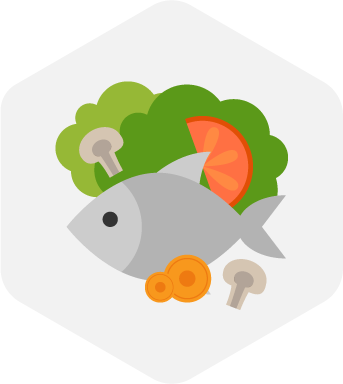Pescetarian

Your bread and butter is no bread and butter
Eat for your brain and get the year round bikini body thrown in for good measure. That’s the Pescetarian diet in a nutshell.
The Pescetarian diet is basically a neurologists dream – lower in carbohydrates and high in beneficial omega-3 fats. Peer reviewed studies like the 2020 PREDICT-1 Trial teach us that some deal better with carbohydrates than do others, and the Pescetarian camp is prone to elevated blood sugar when eating a carbohydrate rich diet.
Their best diet is lower in high glycemic carbs, but only the ones that have a big impact on the insulin response. Bottom line for Pescetarians is yams are fine, white potatoes and grains might be more of an issue. But here’s the rub – with the exception of avoiding dairy, Pescetarians best not fall under the spell of the Paleo camp, a diet with very little science to support it. Paleo doesn’t fit the Pescetarian model because Pescetarians are prone to see cholesterol markers get too high on a diet high in saturated fat. Rather than ordering a Butcher Box, Pescetarians will want a freezer full of Wild Salmon from Bristol Bay instead.
What is the scientific basis for this diet? With macronutrient ratios of 45% healthy fats, 40% carbohydrates, and 15% protein from plant and seafood sources, the Pescetarian diet is consistent with the low protein recommendations advanced by nutrition scientists like Valter Longo. A diet high in healthy fats from nuts and seeds, olive oil, and avocado is recommended as heart healthy by many nutrition scientists. The Pescetarian diet adds about 10% more dietary fat to the meal plan than is called for by United States Dietary Guidelines, but this is based on the growing body of science teaching us that people metabolize fats very differently, especially as LDL is concerned. The Pescetarian diet opts for slightly more healthy fats to compensate for what could be an issue with a high carbohydrate diet in this genotype.
For more on the science of nutrigenomics, see our science page.
Most closely related diet: Pegan
Primary difference with Pegan: The Pescetarian diet, while needing to strictly avoid dairy and sugar, is a little less restrictive than the Pegan diet because Pescetarians have a normal histamine score.
Biggest challenge: Steering diet towards lower carb while still choosing plenty of the “right,” fiber rich carbs can be a tightrope. Pescetarians are tasked with the somewhat unique challenge of going low carb without resorting to bacon and butter at every meal.
Red meat friendly? Nope. Pescetarian dieters needn’t avoid saturated fat altogether, but their best bets are plant sources, like avocado, that pair saturated fat with healthier monounsaturated fats.
Keto friendly: Not in the traditional sense. Pescetarians are more likely to increase their risk for heart disease when eating a higher saturated fat diet. A plant based ketogenic diet that is very high in monounsaturated fats could be a keto option for Pescetarians. Question becomes: how much do you like macadamia nuts and olive oil?
Carnivore diet friendly? No.
Does this diet type handle fermented foods? Yes, please. Pescetarians aren’t likely to have issues with histamine. Collagen, kombucha and sauerkraut are all possibilities.
What about pancakes and refined grains: Refined grains, especially products with added sugar, oils and preservatives aren’t healthy for anyone as a staple, but especially Pescetarians who are at a disadvantage in dealing with the spikes in blood sugar from these processed foods.
Go to breakfast: Smoked salmon and avocado.
